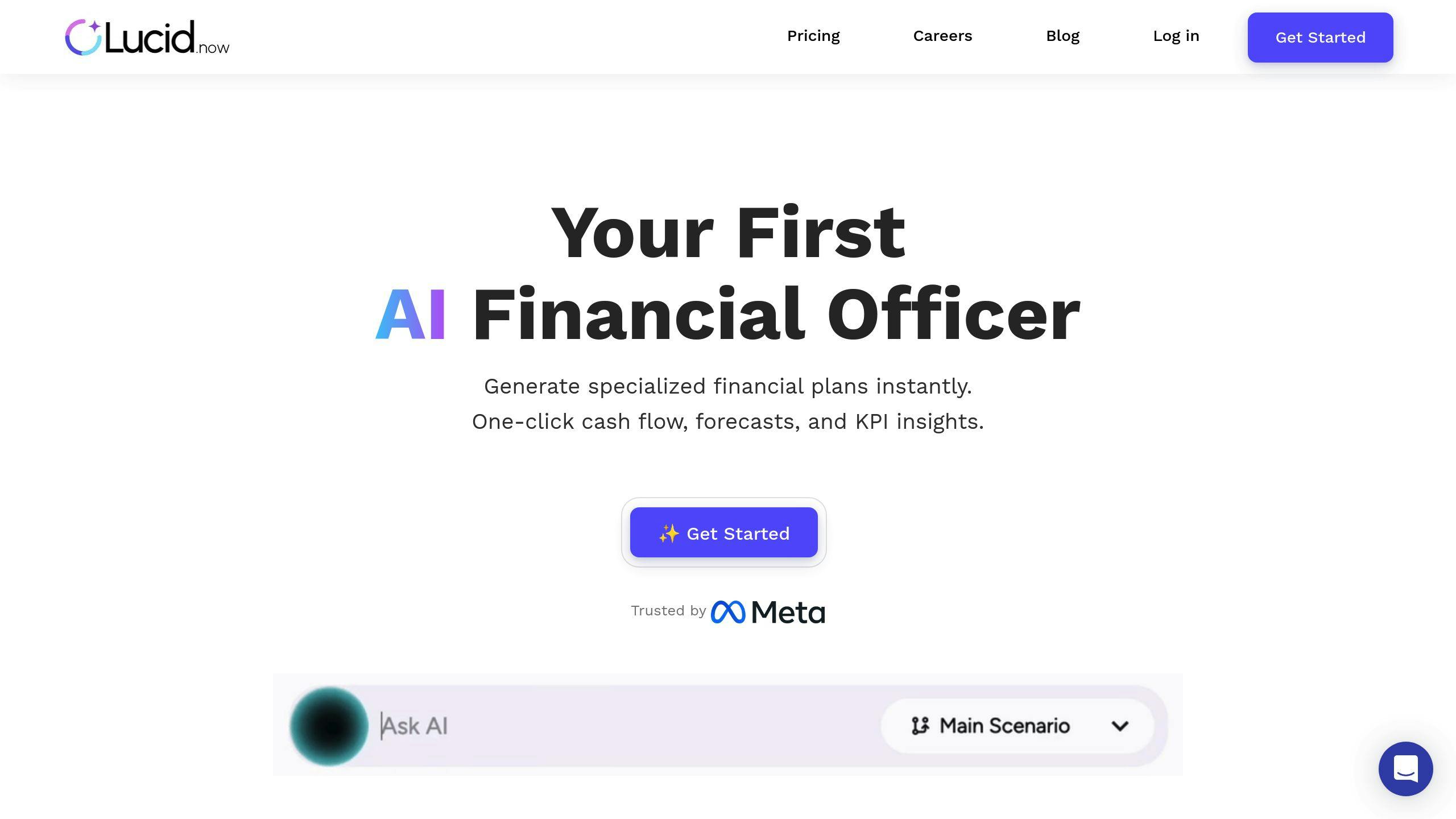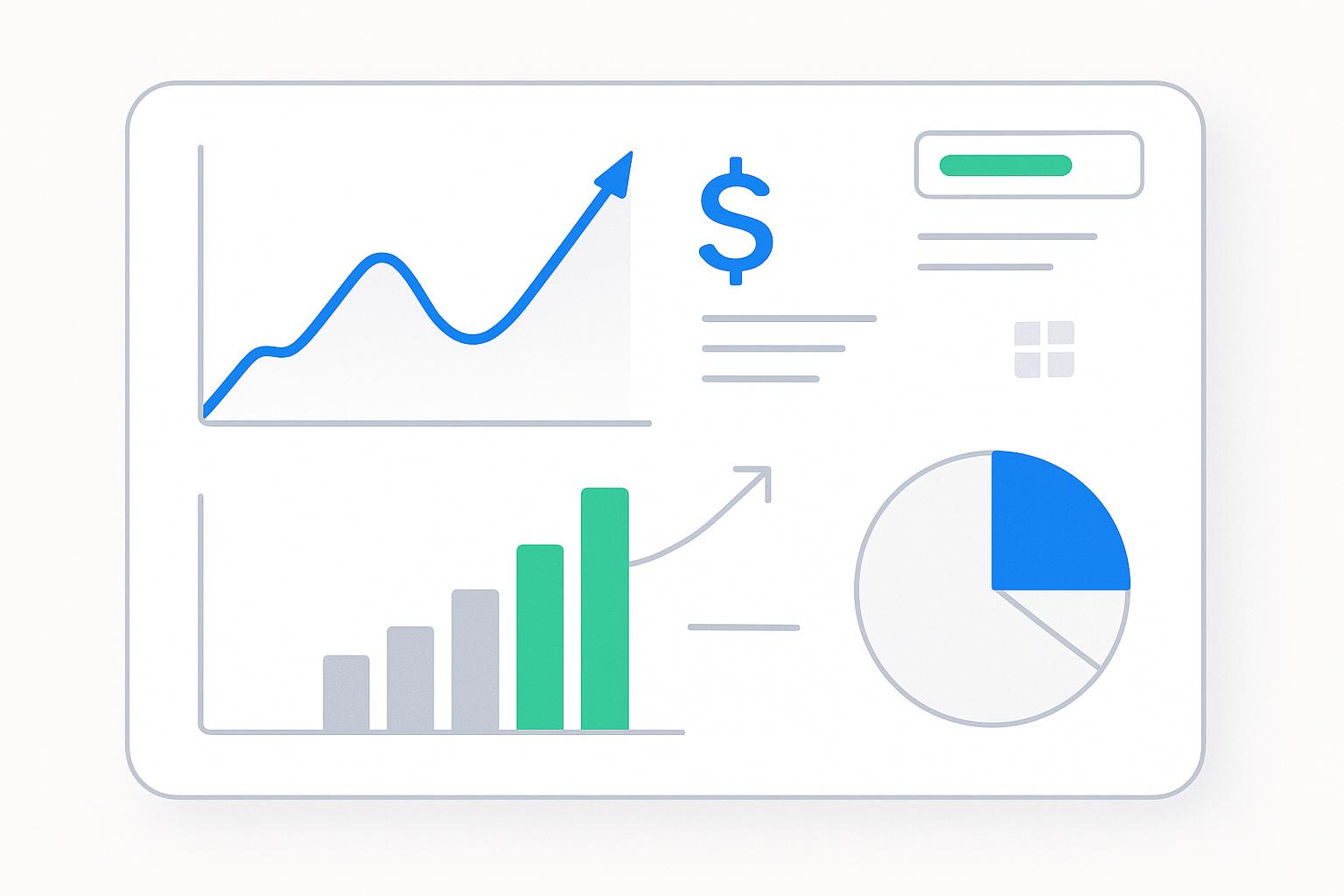Investors evaluate startups using 11 key financial metrics to assess growth potential, profitability, and financial health. These metrics help founders make smarter decisions and demonstrate their business's viability. Here's a quick overview:
- Revenue Growth: Measures market demand and scalability.
- Burn Rate: Tracks cash usage and financial stability.
- Gross Margin: Shows operational efficiency and profit potential.
- Customer Acquisition Cost (CAC): Evaluates the cost-effectiveness of gaining new customers.
- Lifetime Value (LTV): Assesses long-term customer revenue potential.
- Monthly Recurring Revenue (MRR): Predictable, stable income for subscription models.
- Churn Rate: Percentage of customers lost over time.
- Cash Runway: Time a startup can operate with current cash.
- Unit Economics: Profitability per customer or unit.
- Customer Retention Rate: Percentage of customers retained over time.
- Lucid Financials: AI-driven tool to track and optimize these metrics.
Key takeaway: Mastering these metrics is crucial for attracting investors and ensuring long-term growth. Each metric provides insights into different aspects of a startup's performance, from revenue generation to customer retention. Tracking them effectively can set your business apart.
5 Key Financial Metrics Startup Should Track
1. Revenue Growth
Revenue growth is one of the top metrics investors analyze when assessing startups. It not only measures a company's ability to generate sales but also signals market demand and potential for scaling.
Research from CB Insights shows that 42% of startups fail because there’s no market need for their product or service [1]. This explains why investors prioritize revenue growth - it’s a clear sign that customers are willing to pay for the solution being offered.
Take Airbnb as an example. During its early years, the company’s steady revenue growth proved both market demand and its ability to scale. This type of performance aligns with what investors seek: growth that can be maintained over time while addressing market needs.
Lior Ronen, founder of Finro Financial Consulting, sums it up well:
"Revenue growth tells investors where a company is today and where it's headed."
Investors are particularly interested in growth that outpaces industry norms and shows scalability. Many startups now rely on financial planning tools to monitor and improve revenue growth in real time. These tools help with key decisions around pricing strategies and market expansion.
While revenue growth highlights market demand, it’s equally important to evaluate how effectively resources are being managed. This leads us to the next key metric: burn rate.
2. Burn Rate
Burn rate tracks how fast a startup uses up its cash reserves. It’s a key metric for investors to assess whether a business can maintain growth without running out of money. While revenue growth shows demand, burn rate highlights financial stability.
There are two parts to burn rate: gross burn (total monthly cash spent) and net burn (cash spent minus revenue). Together, they offer a snapshot of a startup’s financial health.
For instance, if a startup has $100,000 in cash and spends $20,000 each month, its burn rate is $20,000 per month. This means the company has a runway of five months.
Lior Ronen, founder of Finro Financial Consulting, explains the importance of tracking this metric:
"A well-structured financial model is one of the most powerful tools a founder can use to show investors that they understand their business inside and out." [1]
Startups that succeed in managing their burn rate tend to focus on monitoring cash flow, cutting unnecessary costs, and aligning spending with revenue. Tools for financial planning can help founders track burn rate in real-time, predict runway, and keep investors informed.
Investors often see high burn rates as a red flag since they can point to cash flow problems - one of the top reasons startups fail [3]. Using financial tools to predict runway and adjust spending can help startups stay on track and build trust with investors.
While burn rate measures how fast cash is spent, looking at gross margin can reveal how effectively a startup turns revenue into profit.
3. Gross Margin
Gross margin shows how well a startup turns revenue into profit, giving investors a clear picture of its growth potential and efficiency. To calculate it, subtract Cost of Goods Sold (COGS) from revenue, divide by revenue, and multiply by 100.
Gross margins differ across industries. For example, SaaS companies often see margins of 80-90%, retail businesses average 20-30%, and manufacturing typically falls between 30-40%. High gross margins signal a strong ability to grow profitably, which is why they’re a key factor for investors when considering funding.
"Gross margin reflects operational efficiency and profitability, and the ratio of Customer Acquisition Cost (CAC) to Lifetime Value (LTV) shows whether acquiring customers is sustainable." [1]
Startups can boost gross margins by adjusting pricing, cutting production costs, or scaling operations to reduce expenses. The link between gross margin and burn rate is especially important to investors. A higher margin means more cash from each sale, which can help extend a startup's runway. On the other hand, a lower margin may lead to faster cash burn, limiting flexibility and growth.
Gross margin also ties directly into evaluating Customer Acquisition Cost (CAC) and Lifetime Value (LTV) - two metrics critical for understanding long-term profitability.
4. Customer Acquisition Cost (CAC)
Customer Acquisition Cost (CAC) tells you how effectively a startup turns its marketing and sales expenses into new customers. It’s a key metric for understanding growth and how well resources are being used.
To calculate CAC, divide your total marketing and sales costs (like advertising and salaries) by the number of new customers gained during a specific period. Keep in mind, CAC varies widely between industries. For example, B2B SaaS companies often report lower CAC compared to sectors like real estate or higher education.
Investors often pair CAC with the LTV:CAC ratio to gauge whether growth is on the right track. A ratio of 3:1 or higher is typically seen as a good indicator. That said, a high CAC can still make sense if paired with strong customer retention and a high Lifetime Value (LTV).
Startups are increasingly leveraging technology to lower CAC and make marketing efforts more efficient. Trends in CAC are also important to investors. A declining CAC signals better operational efficiency and scalability, while an increasing CAC might indicate challenges in the market.
While CAC focuses on the cost of gaining customers, balancing it with an understanding of their long-term value is crucial for judging overall profitability.
5. Lifetime Value (LTV)
Lifetime Value (LTV) measures how much revenue a business expects to earn from a single customer over the course of their relationship. This metric is crucial for understanding a startup's long-term revenue potential and planning strategies like customer acquisition and retention.
"Understanding LTV helps you make informed decisions about how much to spend on acquiring new customers and how to prioritize retention efforts." - Lior Ronen, Founder, Finro Financial Consulting [1]
Investors focus on three main factors when analyzing LTV: customer lifespan, average revenue per user (ARPU), and churn rate. Longer customer retention and higher ARPU improve profitability, while a low churn rate ensures customers stick around longer. A high LTV, especially when combined with a low churn rate and strong Monthly Recurring Revenue (MRR), signals that a business is scalable and financially sound.
Startups are increasingly using AI-driven tools like Lucid Financials to track LTV in real time. These tools integrate LTV with other metrics, such as churn and MRR, giving businesses a clearer picture of their financial health. For investors, an LTV:CAC ratio of 3:1 or higher is often seen as a sign of effective customer acquisition and scalability.
While LTV provides insights into long-term revenue, MRR complements it by offering a snapshot of stable, recurring income - both are crucial for assessing a startup's growth potential.
6. Monthly Recurring Revenue (MRR)
Monthly Recurring Revenue (MRR) is a key metric for startups, offering investors a clear view of predictable income. It’s often seen as a strong indicator of a company’s financial health and ability to grow.
"For a subscription business, like a SaaS company, MRR is perhaps the single most important performance metric around." [2]
Calculating MRR is straightforward: multiply the number of active accounts by the Average Revenue Per Account (ARPA). For example, if 50 customers each pay $2,000 a month, the MRR is $100,000.
Investors pay close attention to MRR growth rates. A monthly drop of more than 5% in MRR is a red flag, often signaling retention issues that need to be addressed quickly.
MRR is shaped by three main factors:
- New MRR: Revenue from new customers.
- Expansion MRR: Additional income from upgrades or cross-sells.
- Churned MRR: Revenue lost due to cancellations.
Tools like Lucid Financials go beyond just tracking MRR. They provide insights into revenue trends, helping startups refine their growth strategies. This kind of data supports better forecasting and strategic decision-making, which is crucial for showing financial stability.
Strong MRR growth reflects effective pricing, good customer retention, and operational strength. These are all factors investors consider when evaluating a startup’s potential.
As startups grow, keeping MRR on an upward trajectory becomes even more critical for attracting funding and proving the business model works. MRR ties directly to customer satisfaction, product-market fit, and overall business health.
While MRR gives a snapshot of predictable revenue, keeping an eye on churn rate is just as important to ensure lasting growth.
sbb-itb-17e8ec9
7. Churn Rate
Churn rate shows the percentage of customers who stop using a product or service within a specific time frame. For investors, a low churn rate signals strong customer loyalty and a business model that can scale, which is especially important for subscription-based businesses.
A low churn rate reflects satisfied customers and a solid business foundation. SaaS companies generally aim for churn rates between 5-7%, with top-performing companies keeping their annual churn around 10%. On the other hand, a churn rate exceeding 15% often highlights serious profitability issues [5].
"Churn is a silent killer of SaaS companies - it's like a leak in a bucket."
Here’s the basic formula for calculating churn:
Churn Rate = (Customers Lost / Total Customers at Start) × 100
For example, if a company loses 50 customers out of 1,000 in a month, the churn rate is 5%.
Investors typically focus on two types of churn:
- Voluntary churn: Happens when customers cancel their subscriptions, often due to dissatisfaction or better alternatives.
- Involuntary churn: Results from payment failures, which can point to billing or operational issues.
Tools like Lucid Financials can help businesses spot churn trends and improve retention. Using such tools shows investors that the company is actively addressing customer retention challenges.
The effects of churn go beyond lost revenue. High churn rates mean businesses must constantly spend on acquiring new customers, increasing costs and cutting into profits. Lowering churn allows companies to allocate resources more effectively, extend their cash runway, and prioritize sustainable growth.
Analyzing churn patterns gives investors a clear view of how well a company retains its customers and maintains overall business health. Up next, we’ll discuss cash runway, a metric that highlights how long a company can operate with its current financial resources.
8. Cash Runway
Cash runway measures how long a startup can keep operating before it runs out of cash. It's a key metric for investors who want to evaluate a company's financial health. Essentially, it shows whether a startup has enough time to hit important milestones or secure more funding before the money runs dry.
Here's the formula:
Cash Runway = Cash on Hand ÷ Monthly Burn Rate
Investors generally look for startups with a runway of 18-24 months. Anything shorter signals higher risk. Since burn rate directly affects cash runway, both metrics are essential for financial planning [4].
Startups can extend their runway by taking a few steps: negotiating better terms with suppliers, improving operational efficiency, switching contracts to prepaid agreements, and cutting unnecessary expenses. Many high-profile startup failures have been tied to a lack of runway [1].
Tools like Lucid Financials can help track runway in real time. These tools integrate with accounting systems to provide accurate forecasts and flag potential cash flow problems early.
Cash runway also ties closely to other financial metrics. A company might show strong revenue growth but still face survival challenges if its runway is too short. On the flip side, a longer runway offers breathing room to handle market challenges or seize growth opportunities without scrambling for immediate funding [2].
While cash runway focuses on short-term survival, analyzing unit economics offers insights into a company's long-term financial health.
9. Unit Economics
Unit economics focuses on the revenue and costs tied to a startup’s core business model, calculated on a per-unit basis. This metric helps investors assess whether a startup can achieve long-term profitability as it grows.
The basic formula for unit economics is:
Net Unit Economic Value = Lifetime Value (LTV) - Total Costs Per Customer
A key measure here is the LTV to CAC ratio, which evaluates profitability and growth potential. For example, if acquiring a customer costs $1,000 and that customer generates $100 monthly with an 80% profit margin, the business becomes profitable after 10 months. Investors generally prefer a CAC payback period of less than 12 months [2].
"Most great companies historically have had good unit economics soon after they began monetizing, even if the company as a whole lost money for a long period of time." - Sam Altman, Entrepreneur and Investor [3]
Tools like Lucid Financials make it easier to monitor these metrics in real-time, helping startups adjust customer acquisition spending and pricing strategies based on trends.
Poor unit economics often point to issues like high costs or a limited market. For instance, if a startup needs to sell 1 million subscriptions just to break even, but the total market size is only 10 million potential customers, investors may see this as a red flag [4].
To strengthen unit economics, startups can:
- Cut customer acquisition costs with more precise marketing
- Improve customer retention to boost lifetime value
- Adjust pricing strategies for better margins
- Reduce operational costs per customer
For fast-growing startups, unit economics offers valuable insights into how revenue and profit margins will develop over time, directly influencing investor confidence and potential returns.
While unit economics focuses on profitability, customer retention rates shed light on how well a business keeps its customers over time.
10. Customer Retention Rate
Customer retention rate shows the percentage of customers a business keeps over a set time. While churn rate focuses on customer losses, retention rate highlights how many customers stick around, offering a clearer view of loyalty and recurring revenue stability.
Here’s the formula: ((Customers at End - New Customers) ÷ Customers at Start) × 100. For example, if you start with 100 customers, add 10 new ones, but end with 80, your retention rate is 70%.
Retention rates are key for valuations. High rates suggest strong product-market fit and loyal customers, while low rates might signal problems to address. Comparing rates to industry averages can help gauge performance.
To boost retention, startups can focus on customer success initiatives, personalized outreach, monitoring key data, and providing extra value. Tools like Lucid Financials make it easier to track retention metrics in real-time, helping businesses spot trends and fix issues before they grow.
For startups looking to attract investors, retention rates are especially important. Investors often compare these rates to industry standards to evaluate a company’s competitive edge and growth potential. A steady increase in retention rates can be even more persuasive than the raw numbers, as it shows improving customer satisfaction and operational progress.
Platforms like Lucid Financials can simplify tracking and improving retention, giving startups the insights they need to refine their strategies.
11. Lucid Financials

Managing multiple financial metrics can be overwhelming for startups in today's data-heavy environment. Lucid Financials is an AI-powered tool designed to help startups keep a close eye on the metrics that matter most to investors.
This platform simplifies financial planning by combining real-time tracking, scenario analysis, and industry comparisons. Startups can monitor all ten key metrics mentioned earlier while spotting areas for improvement. Its AI capabilities go a step further, predicting how business decisions will affect these metrics, making it easier to plan growth strategies based on solid data.
For those gearing up for fundraising, Lucid Financials provides tools for scenario analysis, performance comparisons, and investor reporting. The benchmarking feature, in particular, allows startups to measure their metrics against industry norms, highlighting strengths and areas needing attention before meeting with investors.
"Experts recommend that startups use Lucid Financials to regularly review and update their financial plans, ensuring that they are aligned with current market conditions and business strategies", says Erez Lankri, a financial planning specialist and the platform's founder.
Conclusion
Financial metrics act as a guide for startups and investors, helping them make smart, data-driven decisions. The 11 metrics outlined offer a clear way to assess a startup’s overall health, growth potential, and appeal to investors. Each one highlights a different aspect of performance, forming a solid base for building a strong business.
Tracking these metrics isn’t just about attracting investors - it’s about creating a stable and lasting business. Poor financial management is a major reason why startups fail [3], so keeping a close eye on these numbers is crucial.
Startups face the challenge of managing vast amounts of financial data. While the metrics themselves are straightforward, analyzing and acting on them often requires advanced tools and expertise. Modern platforms now provide real-time insights and AI-driven analysis to simplify this process and support smarter decision-making.
Success in today’s startup world hinges on mastering these financial metrics. Regular reviews and expert input ensure healthy numbers and help build trust with investors. By combining strong financial management with the right tools, startups can set themselves up for long-term growth and investor confidence.
FAQs
How do you calculate average burn rate?
To find the average burn rate, sum up the monthly burn rates over a given period and divide that total by the number of months. For instance, if a company spends $100,000 per month over three months, the average burn rate would be $100,000 per month [1].
Tools like Lucid Financials simplify this process. By connecting directly to your accounting systems, these platforms automate calculations and provide real-time financial insights. This helps startups stay on top of their spending and present a clear picture of financial health to investors.
"Burn rate provides key visibility into a company's fiscal health and sustainability." - TRUiC [3]
Knowing how to calculate and monitor your burn rate is crucial for managing cash flow and addressing the metrics that investors care about most when evaluating a startup's potential.


